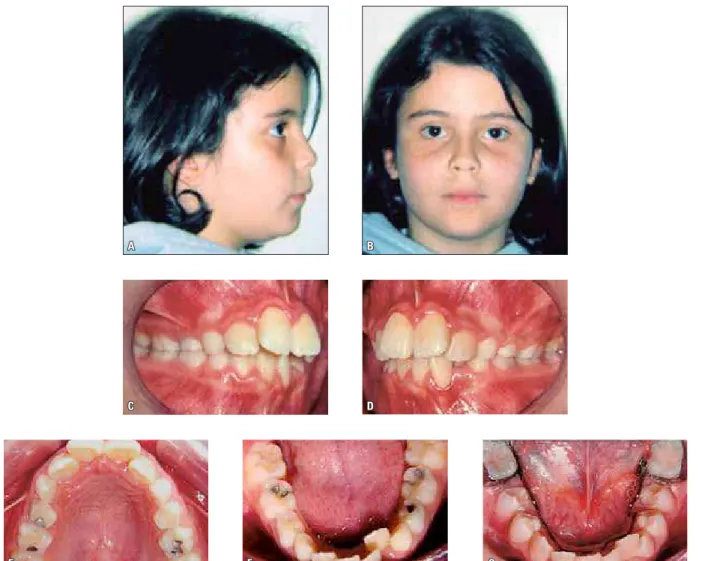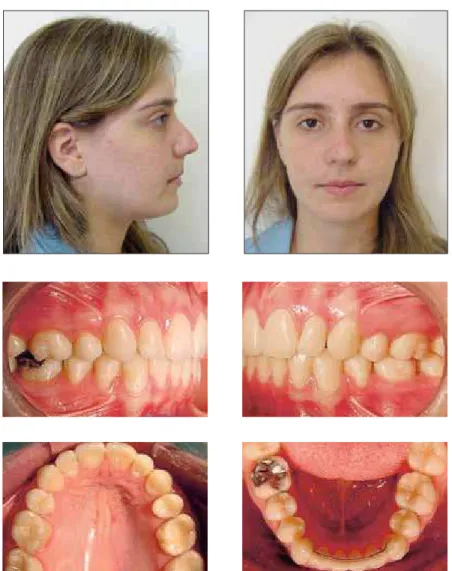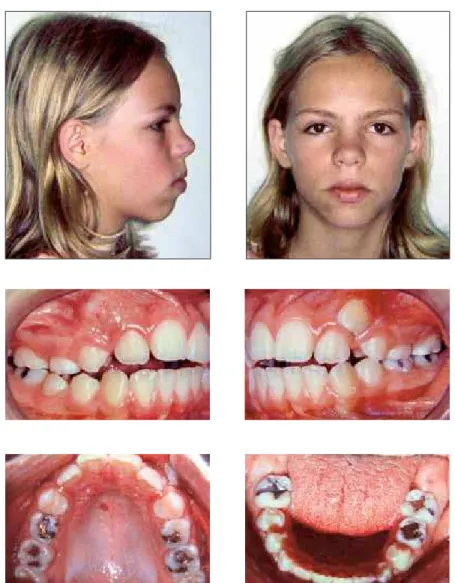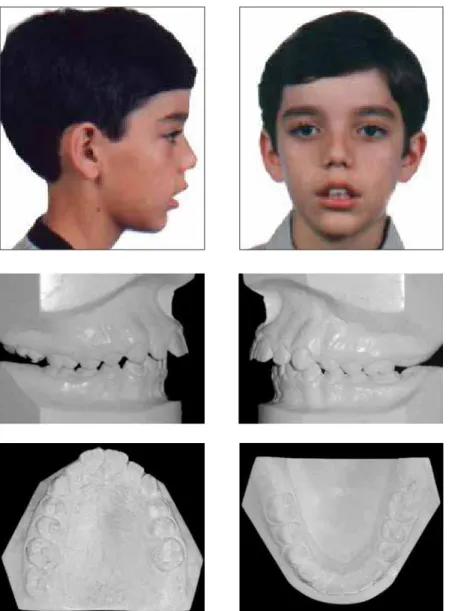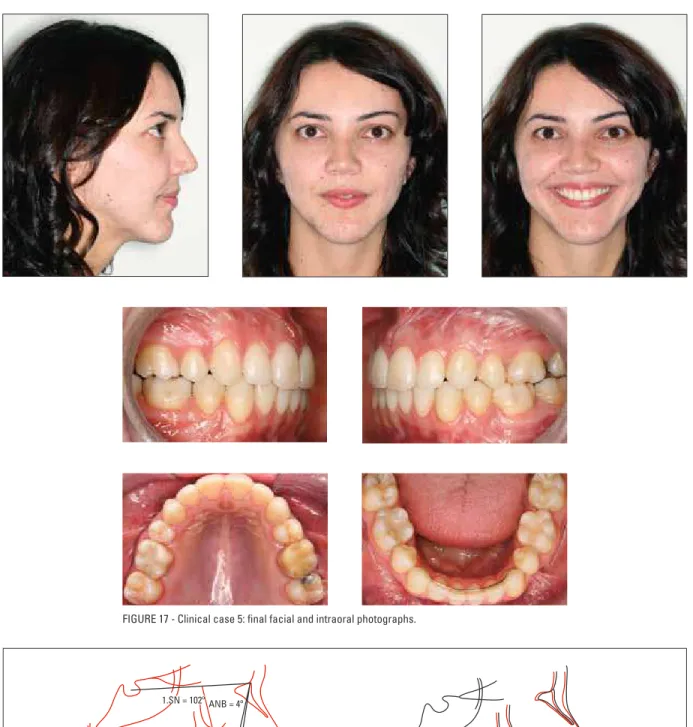SP E C I A L AR T I C L E
Tooth extraction in orthodontics:
an evaluation of diagnostic elements
Antônio Carlos de Oliveira Ruellas*, Ricardo Martins de Oliveira Ruellas**, Fábio Lourenço Romano***, Matheus Melo Pithon**, Rogério Lacerda dos Santos**
Certain malocclusions require orthodontists to be capable of establishing a diagnosis in order to determine the best approach to treatment. The purpose of this article was to present clinical cases and discuss some diagnostic elements used in drawing up a treat-ment plan to support tooth extraction. All diagnostic eletreat-ments have been highlighted: Issues concerning compliance, tooth-arch discrepancy, cephalometric discrepancy and facial profile, skeletal age (growth) and anteroposterior relationships, dental asymmetry, facial pattern and pathologies. We suggest that sound decision-making is dependent on the factors mentioned above. Sometimes, however, one single characteristic can, by it-self, determine a treatment plan.
Abstract
Keywords: Corrective Orthodontics. Diagnosis. Tooth extraction. Orthodontic planning.
* PhD in Orthodontics, Federal University of Rio de Janeiro (UFRJ). Associate Professor, Department of Orthodontics, UFRJ. ** MSc in Orthodontics, Federal University of Rio de Janeiro (UFRJ).
*** PhD in Orthodontics, University of Campinas (UNICAMP). Professor of Orthodontics, School of Dentistry, Ribeirão Preto, University of São Paulo (USP).
IntroductIon
Since the early days of orthodontics the need for tooth extractions in certain orthodontic sit-uations has been discussed. In the early twenti-eth century, Angle favored non-extraction orth-odontic treatment based on the concept of the occlusion line.23 He believed it possible to cor-rectly position all of the 32 teeth in the dental arches and, as a result, the adjacent tissues (teg-ument, bone and muscle) would adapt to this new position. Grounded in this belief, he taught his students and treated numerous cases.24
One of Angle’s chief opponents was Calvin Case, who advocated orthodontic treatment with extraction in some cases. He asserted that dental extractions should never be undertaken in order to facilitate orthodontic mechanics but rather to provide the best possible treatment for the patient.2
those in which the lower incisors did not end in a vertical position relative to its bony base. In such cases, he re-treated patients by extracting four premolars, thereby achieving better func-tional and aesthetic results. Tweed went from staunch follower to strong opponent of Angle’s non-extractionist ideas, despite sustaining heavy criticism by his peers.23
This dichotomy remains to this day. The di-agnosis of some malocclusions can be ambigu-ous in terms of the need for extractions. Ac-cording to Dewel,7 the challenge of orthodontic diagnosis is not in those cases that reportedly require extractions or those that clearly do not, but in a large group known as borderline cases. The literature is not consistent with respect to the value of negative discrepancy in the lower arch, a feature that would characterize such cas-es. Total discrepancy variations ranging between -3 mm and -6 mm are, however, acceptable to define the case as borderline. Keedy11 remarked that diagnosis is determined by muscle tension and post-treatment stability. Williams26 noted that in most borderline cases patients exhibit an appropriate and acceptable skeletal pattern and adequate soft tissue balance, a condition that is often indicated for extraction—in 5% to 87% of cases—by different professionals.
In any malocclusion, and particularly in a borderline case, it is necessary to evaluate the patient’s dental, facial and skeletal characteris-tics to establish a correct diagnosis and effective treatment plan. We will discuss some of these characteristics, known as diagnostic elements, which must be carefully considered in deciding whether or not to perform extractions in orth-odontic treatment planning.
Deciding on extraction involves more than just the need to obtain space in the arches, be it designed to align teeth or retract anterior teeth. Sometimes, an extraction made to align teeth can compromise facial esthetics, rendering the profile more concave. However, obtaining space
at the expense of moving posterior teeth distally can also compromise aesthetics by making the lower facial third longer, which can make it more difficult to achieve adequate lip closure. We set out to evaluate seven issues to help us make the right decision and to serve as qualitative guides. In other words, it does not mean that the pres-ence of six favorable items will determine an extraction, since there are cases where only one item can be crucial to the decision.
coMPLIAncE
All orthodontic treatment requires patient compliance in, for example, maintaining ad-equate oral hygiene, not breaking or damag-ing the orthodontic accessories, or simply at-tending regular appointments. Certain types of malocclusion, however, require additional compliance to ensure treatment success. To correct certain types of Class II malocclusion, especially those of a skeletal origin, patients must wear a headgear. Moreover, in the treat-ment of Class III malocclusion with maxillary deficiency (patient with growth potential), the use of maxillary protraction face mask is also indicated.18 In most treatments, the regular use of intermaxillary elastics as an aid in the cor-rection of malocclusion or in the final treat-ment stage—for intercuspation—also requires patient compliance. All the resources men-tioned above pose patient compliance difficul-ties involving potential aesthetic concerns.
Tooth extraction in orthodontics: an evaluation of diagnostic elements
this factor in their treatment. When significant cooperation is required it is suggested that a restudy be conducted after a certain period of time since, if compliance is indeed an issue, the orthodontist will not be able to fully rely on this factor to resolve borderline cases.
Sometimes lack of compliance can extend treatment time and even lead to reviews of the initial planning, requiring dental extractions.
Class II malocclusions with an adequate lower arch can be corrected by moving the upper teeth distally with the use of elastics or headgear. Both require substantial patient compliance. Alternatively, distal movement can be achieved with mini-implant support, or orthodontic correction can be accomplished by extracting upper premolars, which requires virtually no patient cooperation.
Some treatment plans can achieve similar results whether conducted with or without extractions (especially borderline cases). How-ever, others may have their treatment outcome jeopardized if planning was based on patient-dependent mechanics and the patient failed to respond accordingly.
tootH-ArcH dIscrEPAncy
This discrepancy should be evaluated in both the upper and lower arches. But for di-agnostic purposes, the lower arch is a priority because of greater difficulty in obtaining space.
When orthodontists are faced with a marked negative tooth-arch discrepancy (TAD) in the lower arch, they will be hard pressed to treat the patient by performing tooth extractions. Small negative discrepancies can, in most cases, be treated without extractions. Thus, space can be obtained by using leeway space (if still possible), stripping, correction of pronounced mesial tip-ping of lower posterior teeth and small expan-sions and/or protruexpan-sions with the goal of restoring normal tipping to the lower teeth, especially if ac-companied by rapid maxillary expansion (RME).
The clinical case 1 illustrates the situation of using leeway space to avoid extractions. The 9 year-old patient had a negative discrepancy in the upper and lower arches (Fig 1). To solve this case, we could choose for upper and lower premolar extractions. Although the profile was slightly convex, we opted for treatment using leeway space in the lower arch, placement of lingual arch during the mixed dentition (Fig 1G) and rapid maxillary expansion in the up-per arch. With this therapeutic approach we achieved tooth alignment without the need to perform extractions and obtained a straight profile, which probably would have been in worse shape if the case had been conducted with tooth extractions (Figs 2 and 3).
Another situation typical of negative discrep-ancy cases is when the need arises to perform tooth extractions but no changes can be made to the facial profile. In the clinical case 2, the patient’s facial profile was straight with negative discrepancy in the upper and lower arches and asymmetry in the lower arch (Fig 4) with lower midline shift to the right. To solve this case we chose to extract three premolars (14, 24 and 34). To avoid excessive retraction of anterior teeth towards lingual and deepening of the profile, we used resistant torque in the upper and lower teeth during retraction and avoiding incisor up-righting. The result at the end of treatment was dental harmony in the existent space, with main-tenance of the facial profile (Fig 5).
Zero or positive model discrepancies re-quire that treatment be performed without extractions, unless the patient has some other associated problem that indicates extraction.
A B
C D
E F G
discrepancy. Negative discrepancies in the low-er arch between 5 mm and 9 mm allow treat-ment to be performed with or without extrac-tions, depending on the characteristics of the patient and the orthodontic mechanotherapy that was used. Finally, for negative discrepan-cies of more than 10 mm extraction is almost always required, preferably of first premolars because second premolar extraction is not suit-able for large discrepancies.
When deciding to solve a TAD with extrac-tions, changes in the profile due to retraction of anterior teeth and likely decrease in the lower face should be considered. But if the decision is for addressing the negative TAD without extrac-tions, the likelihood of an increased lower face caused by the distal movement of posterior teeth in order to create space should be taken into ac-count. These mechanisms are directly related to the facial pattern, as discussed below.
A B C
Tooth extraction in orthodontics: an evaluation of diagnostic elements
FIGURE 2 - Clinical case 1: final facial and intraoral photographs.
FIGURE 4 - Clinical case 2: initial facial and intraoral photographs.
cEPHALoMEtrIc dIscrEPAncy (cd) And FAcIAL ProFILE
In situations of pronounced labial tipping of the incisors with a high CD and expressive facial convexity, extractions are often neces-sary to retract these incisors, improving the patient’s profile.
The current trend in orthodontic diagnosis is to focus more on facial features and rely less on cephalometric measurements. Therefore, some-times a case is finished with protrusive incisors
so as not to alter a satisfactory profile, whereas one can resort to stripping to create spaces that would allow these teeth to be slightly uprighted.
Tooth extraction in orthodontics: an evaluation of diagnostic elements
FIGURE 5 - Clinical case 2: final facial and intraoral photographs.
FIGURE 6 - Total superimposition.
Subsequently, the changes in the patients’ pro-file were evaluated using cephalometric mea-surements. There were no significant differenc-es in both evaluations, which led the authors to conclude that changes in the profile were not as evident for each type of treatment.
0.75 mm. Other authors found lower values for this ratio (1/0.64 - Talass et al;20 1/0.5 - Mas-sahud and Totti14). Regarding the lower lip, for every 1 mm of lower incisor retraction, it retracts 0.6 mm12 or 0.78 mm14. Thus, space closure per-formed by retracting anterior teeth tends to ren-der the profile more concave.
There are situations where although the facial profile is concave, orthodontic planning indicates extraction in order to address issues of crowding and/or anteroposterior dental asymmetries.
It is noteworthy that facial esthetics is in-creasingly valued by patients and that facial profile becomes more concave with age. Cases should therefore be preferably finished with slightly protruding profiles to prevent them from becoming concave in future. Adult pa-tients should avoid excessive relocation of an-terior teeth towards lingual for it may highlight creases and wrinkles, and impart an immediate perception of facial aging.
Figures 7 and 8 (clinical case 3) show a patient aged 11 years, convex profile, skeletal Class II (ANB = 6º), dental Class I, zero low-er TAD, 2 mm ovlow-erjet, 3 mm open bite, well positioned upper incisor (1. SN = 103º) and protruding lower incisor (IMPA = 110º). As aggravating factors, the patient presented with mouth breathing and difficulty in sealing the lips. Also noticeable were an increased lower facial third and lack of space for eruption of maxillary canines.
Based on these assessments, we opted for orthodontic treatment combined with extrac-tions of teeth 14 and 24 with the goal of align-ing and levelalign-ing the upper canines and teeth 35 and 45 for lower incisor retraction and mesial movement of teeth 36 and 46. A vertical chin cup was also used during nighttime for vertical control, thereby avoiding extrusions.
At the end of treatment there was improve-ment in the facial profile and correction of
dental relations (Figs 9 and 10). The final profile was not fully repositioned and was finished with a slight protrusion in order to avoid the prema-ture aging of the patient.
sKELEtAL AgE (groWtH) And AntEroPostErIor rELAtIonsHIPs
In malocclusions with skeletal discrepancies it is crucial—for the diagnosis and prognosis of the case—to check whether the patient is still undergoing significant facial growth. Maximum pubertal growth spurt occurs approximately at around 11-12 years in girls and 13-14 years in boys, subject to individual variations.16 The most widely used method for assessing skeletal age is through a hand and wrist radiograph, by analyzing the size of the epiphyses relative to the diaphyses.9 If a patient is in his/her develop-ment period it is not possible to correct a skel-etal dysplasia with the use of appliances that produce orthopedic effects.
If a malocclusion can be corrected with growth response (growth redirection), clini-cians can handle the case without extractions.
Figures 11 and 12 show a case with these characteristics. We achieved skeletal and den-tal correction using headgear associated with a fixed orthodontic appliance. Initially, this 11 year-old patient had a convex profile, Skeletal Class II (ANB = 8º), Angle Class II, division 1, 2 mm lower TAD, 8 mm overjet, 5% overbite, well positioned upper incisors (1.SN = 101º), protruding lower teeth (IMPA = 99) and in-creased lower facial third. As an aggravating factor, the patient had a thumb-sucking habit, mouth breathing and a predominantly vertical resultant growth (SN.GoGn = 40º).
1.SN = 103º ANB = 6º
IMPA = 110º Tooth extraction in orthodontics: an evaluation of diagnostic elements
FIGURE 7 - Clinical case 3: initial facial and intraoral photographs.
A B
1.SN = 100º
IMPA = 102º ANB = 4º
FIGURE 10 - A) Final cephalometric tracing. B) Comparison of initial and final profiles.
IMPA = 99º ANB = 8º
SN.GoGn = 40º 1.SN = 101º
Tooth extraction in orthodontics: an evaluation of diagnostic elements
FIGURE 11 - Clinical case 4: initial facial and casts photographs.
FIGURE 12 - Initial cephalometric tracing.
At the end of treatment we achieved the correction of dental and skeletal relationships (ANB = 3º) at the expense of restricting the anteroposterior and vertical maxillary growth, in addition to the distal movement of the up-per teeth and adequate anterior mandibular growth response.
As a result of a better dental and skeletal positioning the patient developed a passive lip seal (Figs 13 and 14).
A B
1.SN = 95º
SN.GoGn = 39º
IMPA = 93º ANB = 3º
FIGURE 13 - Clinical case 4: final facial and intraoral photographs.
Tooth extraction in orthodontics: an evaluation of diagnostic elements
a viable alternative would be the extraction of teeth to solve occlusal disorders, which would mask the skeletal problem, or otherwise perform orthognathic surgery.
Orthodontic retreatment often occurs be-cause the correction of the skeletal problem, which could have been performed during the growth spurt period, sometimes is not appropri-ately addressed. Therefore, during retreatment, extractions arise as a possible solution to solve anteroposterior discrepancies. Retreatment can become more complex due to some usual limi-tations: the best option has already been wasted, teeth have been extracted, root resorption may be present, the patient is under emotional dis-tress and is no longer growing.
When a first treatment was performed in which growth was not been used for maloc-clusion correction and dental extractions were made, one approach to be discussed is the orthodontic treatment combined with or-thognathic surgery. Clinical case 5 clearly il-lustrates this situation.
Figures 15 and 16 show a 26 year-old fe-male patient with a convex profile, skeletal Class II, Angle Class II, division 2 malocclu-sion, zero lower TAD, 4 mm overjet, 40% overbite, excessive exposure of maxillary inci-sors, increased lower facial third, teeth 35 and 45 congenitally missing, teeth 14 and 24 ex-tracted in a previous treatment. The patient’s main complaint regarded her dental and facial aesthetics. The two possible solutions to this case would be either to distalize some upper teeth to achieve dental correction only, which would probably worsen her facial aesthet-ics, or to eliminate any dental tipping used as compensation, subsequently performing or-thognathic surgery with maxillary impaction and mandibular advancement.
Based on the patient’s complaint, we opted for the surgical treatment with leveling and alignment, elimination of dental compensations,
extraction of teeth 18, 38 and 48, impaction of the maxilla, mandibular advancement and ge-nioplasty.
The results included harmonic occlusal rela-tionships with adequate positioning of the teeth in their bony bases and correction of skeletal disharmonies (Figs 17 and 18).
dEntAL AsyMMEtry
The assessment of dental and facial aes-thetic is an important factor in the process of orthodontic diagnosis and treatment plan-ning. One of the biggest challenges in these two tasks is the correct positioning of the up-per and lower dental midlines relative to each other and to the face.4
According to Strang,19 the harmonic posi-tioning of the midlines relative to each other and to the face is what characterizes normal occlusion, and any variation in this combina-tion is indicative of improper relacombina-tionship be-tween the teeth or dental arches. This requires a careful diagnosis because properly assessing the causes behind midline shifts allows profes-sionals to use unique mechanics and asymmet-ric extractions.21
According to Lewis,13 several methods are proposed for diagnosing midline shifts. Chiche and Pinault6 reported that assessment should be based on three factors: the center of the upper lip, the position of the papilla and central incisor tipping. The diagnosis can also be accomplished using well-molded plaster casts,5 marking two or three points in the posterior-most region of the midpalatal raphe and positioning the reticu-late preticu-late over these points.16
1.SN = 94º ANB = 7º
SN.GoGn = 46º
IMPA = 82º
FIGURE 15 - Clinical case 5: initial facial and intraoral photographs.
A B 1.SN = 102º
IMPA = 86º ANB = 4º
SN.GoGn = 42º
Tooth extraction in orthodontics: an evaluation of diagnostic elements
FIGURE 18 - A) Final cephalometric tracing. B) Total superimposition.
Patients presenting with severe dental mid-line deviation relative to the face (especially in the lower arch) require tooth extractions. Small asymmetries can be corrected with in-termaxillary elastics or mini-implants (in some cases, unilateral mechanics), asymmetric ex-tractions, stripping, and in a few situations, orthodontists will have to settle for complet-ing orthodontic treatment with a little midline deviation. The lack of coincidence between the dental and facial midlines is more noticeable in the upper arch and is unsightly. This deviation can be the main reason for many patients to seek orthodontic treatment.
To illustrate this situation we will discuss clinical case 6, an 18 year-old female patient, who had a skeletal Class II malocclusion (ANB = 8º), upper and lower incisors well positioned (1.SN = 104º and IMPA = 92º), straight facial profile (UL-S = 2 mm and LL-S = 1 mm). Re-garding the dental relationship, the case pre-sented with a large lower asymmetry due to a prior treatment which had extracted tooth 44 only, a -3 mm lower TAD, 2 mm overjet, 50% overbite (Figs 19 and 20).
Based on these diagnostic data, we opted for extracting tooth 34 to correct the lower asym-metry. Although the extraction of this tooth alone would correct the lower asymmetry it would also cause the left canine relationship to go into Class II. To avoid this undesired effect, the upper second premolars had to be extracted (teeth 15 and 25). The extraction of tooth 25 enabled the maintenance of normal occlusal re-lationship in the left canines, and of tooth 15 maintained the upper arch symmetry.
Initially, a question may still remain un-answered when evaluating this clinical case. How can we prevent dental extractions from worsening the profile of this patient, which looked so appropriate at the start of treat-ment? To avoid worsening the profile, we used mechanical resistant torque resources, labial
crown in the lower incisors and omega loops that were well adjusted to the second molar tubes so as to avoid the lingual repositioning of the lower incisors, as well as mini-implant support to lose anchorage in the lower right hemi-arch. By following the procedures de-scribed above we were able to complete treat-ment having achieved the correction of the Class II malocclusion without compromising the facial profile (Figs 21 and 22).
It should be emphasized that after treatment completion, the patient underwent a rhinoplas-ty to further improve her profile aesthetics.
FAcIAL PAttErn
Patients with different facial patterns require different mechanics, and responses to orthodon-tic treatment are not similar. Dolichofacial pa-tients feature increased facial height relative to the width, exhibiting a long, narrow and pro-truding face. Furthermore, they have hypotonic facial muscles in the vertical direction and can therefore present with anterior overbite.8 These patients normally suffer from greater anchorage loss, which helps in closing spaces. Greater con-trol should be exercised, however, in order to avoid excessive anchorage loss and the conse-quent lack of space to ensure the planned cor-rection. Extrusive mechanics should be avoided, as well as distal tooth movement.
1.SN = 104ºANB = 8º
IMPA = 92º Tooth extraction in orthodontics: an evaluation of diagnostic elements
FIGURE 19 - Clinical case 6: initial facial and intraoral photographs.
A B IMPA = 92º
1.SN = 97º ANB = 6º
FIGURE 22 - A) Final cephalometric tracing. B) Total superimposition.
Tooth extraction in orthodontics: an evaluation of diagnostic elements
The literature suggests the removal of pos-terior permanent teeth first, with subsequent loss of anchorage, to correct anterior open bite by means of counterclockwise rotation of the mandible.1,15 Moreover, some authors10 ques-tion this associaques-tion between growth reducques-tion and vertical extractions.
However, clinical experience shows that moving the posterior teeth distally tends to cause the opening of the mandibular plane, especially in patients who have already gone through the growth spurt or those who exhibit an unfavor-able growth pattern (predominantly vertical), which leads to the need for more extractions. On the other hand, extractions performed in asso-ciation with vertical control (use of vertical chin cup, high-pull headgear, mini-implants, non-use of extrusive mechanics) may result in the closure of the mandibular plane and/or control of ver-tical facial growth, with decreased lower facial third, improving lip seal (Figs 7-10).
To clarify this situation we present clinical case 7 (Fig 23), where we performed orthodon-tic treatment in a patient with a verorthodon-tical facial pattern. The clinical examination revealed an-terior and posan-terior open bite. According to the treatment plan there was an indication for the extraction of upper second molars, preserving teeth 18 and 28, besides the placement of orth-odontic mini-implants to intrude the maxillary molars, moving them distally while maintain-ing anchorage durmaintain-ing retraction. Mandibular crowding was resolved by stripping, especially incisors with a triangular shape and with the presence of black spaces, when aligned. The re-sults achieved in this case were the correction of the Class II dental relationship with bite clo-sure by intrusion of the upper molars (Fig 24). The superimposition shows the total intrusion of the upper molars, a decreased mandibular plane as a result of the counterclockwise rota-tion of the mandible, and the consequent open bite closure (Fig 25).
PAtHoLogIEs
Some pathologies play a key role in defin-ing orthodontic treatment planndefin-ing. Patients can have half-formed teeth, ageneses, ectopias, abnormal shapes or even carious processes, and endodontic lesions that indicate tooth extrac-tion. During diagnosis these conditions should be considered as they may change—in certain situations—the choice of the tooth or teeth to be extracted.
In patients with an indication for premolar extraction due to a sharp negative model discrep-ancy, but with extensive decay in the first perma-nent molars, these teeth are a viable extraction alternative for the premolars.22 In asymmetric malocclusions, where only one tooth must be ex-tracted, if the patient happens to have an anom-alous tooth, this tooth should be selected for extraction. Many other pathological conditions such as cysts, abnormal roots and periodontal problems indicate the extraction of teeth. Thus, the different pathologies greatly contribute to orthodontic treatments involving extraction.
Clinical case 8 is of a female 10 year-old pa-tient and illustrates the importance of patholo-gies in deciding which tooth to extract. She was in the mixed dentition phase and had an Angle Class I malocclusion, 3 mm anterior open bite, mouth breathing, upper midline shifted due to a missing tooth (21) and skeletal Class II rela-tionship. The maxilla was slightly contracted with no crossbite and she had a 6 mm lower arch model discrepancy (Figs 26 and 27).
FIGURE 23 - Clinical case 7: initial facial and intraoral photographs.
The panoramic radiograph (Fig 27A) dis-closed an inverted (intraosseous) position of tooth 21 with an irregularity in the root por-tion suggestive of lacerapor-tion. The lateral ceph-alometric radiograph showed an angle of ap-proximately 90º between the root and crown of the central incisor.
The patient had a prior habit of thumb suck-ing, which accounted for the anterior open bite
and was maintained thereafter by the anterior posture of the tongue.
Tooth extraction in orthodontics: an evaluation of diagnostic elements
FIGURE 24 - Clinical case 7: final facial and intraoral photographs.
A B
1.SN = 100º
ANB = 6º
IMPA = 89º SN.GoGn = 42º FIGURE 26 - Clinical case 8: initial facial and intraoral photographs.
tooth 21. Thus, the case was treated with the extraction of teeth 14, 21, 34 and 44.
At the end of treatment, the patient’s verti-cal pattern was maintained (SNGoGn = 40º / YSn axis = 73°) thanks to the dental extrac-tions and use of a combined extraoral traction
headgear, and minimizing—with this mechan-ics—the extrusive vector. The headgear im-proved the anteroposterior relationship of the bony bases (ANB = 2º), changing the case from a skeletal Class II to a Class I relationship (Figs 28 and 29).
1.SN = 104º
ANB = 2º
IMPA = 89º SN.GoGn = 40º
B A
Tooth extraction in orthodontics: an evaluation of diagnostic elements
FIGURE 28 - Clinical case 8: final facial and intraoral photographs.
contact address
Antônio Carlos de Oliveira Ruellas Rua Expedicionários nº 437, ap. 51 – Centro CEP: 37.701-041 – Poços de Caldas / MG Email: antonioruellas@yahoo.com.br
Posted on: March 2010 Revised and accepted: April 2010
1. Aras A. Vertical changes following orthodontic treatment in skeletal open bite subjects. Eur J Orthod. 2002;24(2):407-16. 2. Bernstein L, Edward H. Angle versus Calvin S. Case: extraction
versus nonextraction. Historical revisionism. Part II. Am J Orthod Dentofacial Orthop. 1992;102(7):546-61. 3. Boley JC, Pontier JP, Smith S, Fulbright M. Facial changes
in extraction and nonextraction patients. Angle Orthod. 1998;68(1):539-46.
4. Burstone CJ. Diagnosis and treatment planning of patients with asymmetries. Semin Orthod. 1998;4(4):153-64.
5. Camargo ES, Mucha JN. Moldagem e modelagem em
Ortodontia. Rev Dental Press Ortod Ortop Facial. 1999;4(2):37-50.
6. Chiche GJ, Pinault A. Estética em próteses ixas anteriores. São
Paulo: Quintessence; 1996. 202 p.
7. Dewel BF. Second premolar extraction in orthodontics. Principles procedures and case analysis. Am J Orthod. 1955;41(2):107-20.
8. Enlow DH. Crescimento facial. 3ª ed. São Paulo: Artes Médicas; 1993. 553 p.
9. Fishman LS. Radiographic evaluation of skeletal maturation.
A clinically oriented method based on hand-wrist ilms. Angle
Orthod. 1982;52(3):88-112.
10. Hans MG, Groisser G, Damon C, Amberman D, Nelson S, Palomo JM. Cephalometric changes in overbite and vertical
facial height after removal of 4 irst molars or irst premolars.
Am J Orthod Dentofacial Orthop. 2006;130(6):183-8. 11. Keedy LR. Indications and contra indications for extraction in
orthodontics treatment. Am J Orthod. 1975;68(1):554-63. 12. Kusnoto J, Kusnoto H. The effect of anterior tooth retraction on
lip position of orthodontically treated adult Indonesians. Am J Orthod Dentofacial Orthop. 2001;120(2):304-7.
13. Lewis P. The deviated midline. Am J Orthod. 1976;70(3):601-18. 14. Massahud NV, Totti JIS. Estudo cefalométrico comparativo
das alterações no peril mole facial pré e pós-tratamento
ortodôntico com extrações de pré-molares. J Bras Ortodon Ortop Facial. 2004;9(2):109-19.
rEFErEncEs concLusIons
Any decision regarding the need for extrac-tion of teeth during orthodontic therapy is not only dependent on the presence or absence of
space in the dental arches. Other issues should be evaluated in order to achieve proper maloc-clusion correction, maintenance or improve-ment of facial aesthetics and result stability.
15. Moreira TC. A frequência de exodontias em tratamentos ortodônticos realizados na clínica do curso de mestrado em Ortodontia da Faculdade de Odontologia da UFRJ. [dissertação]. Rio de Janeiro: Faculdade de Odontologia da Universidade Federal do Rio de Janeiro, 1993.
16. Profit WR, Fields JRW. Ortodontia contemporânea. 3ª ed. Rio de
Janeiro: Guanabara Koogan; 1995.
17. Ramos AL, Sakima MT, Pinto AS, Bowman J. Upper lip changes correlated to maxillary incisor retraction – a metallic implant study. Angle Orthod. 2005;75(3):435-41.
18. Roberts CA, Subtelny JD. Use of the face mask in treatment of maxillary skeletal retrusion. Am J Orthod Dentofacial Orthop. 1988;93(4):388-94.
19. Strang RHW. A text-book of Orthodontia. 3rd ed. Philadelphia:
Lea & Febiger; 1950. 825 p.
20. Talass MF, Tollaae L, Baker RC. Soft-tissue proile changes
resulting from retraction of maxillary incisor. Am J Orthod Dentofacial Orthop. 1987;91(7):385-94.
21. Tanaka OM. Avaliação e comparação de métodos de diagnóstico do posicionamento das linhas medianas dentárias no exame clínico e nos modelos em gesso ortodôntico. [tese]. Curitiba: Pontifícia Universidade Católica do Paraná, 2000.
22. Telles CS, Urrea BEE, Barbosa CAT, Jorge EVF, Prietsch JR, Menezes LM, et al. Diferentes extrações em Ortodontia (sinopse). Rev SBO. 1995;2(2):194-9.
23. Vaden JL, Dale JG, Klontz HA. O aparelho tipo Edgewise de
Tweed-Merriield: ilosoia, diagnóstico e tratamento. In: Graber
TM, Vanarsdall RL. Ortodontia: princípios e técnicas atuais. Rio de Janeiro: Guanabara Koogan; 1996. 897 p.
24. Vilella OV. Manual de cefalometria. Rio de Janeiro: Guanabara Koogan; 1995.
25. Wertz RA. Diagnosis and treatment planning of unilateral Class II
malocclusions. Angle Orthod. 1975;45(4):85-94.
26. Williams DR. The effect of different extraction sites upon incisor
